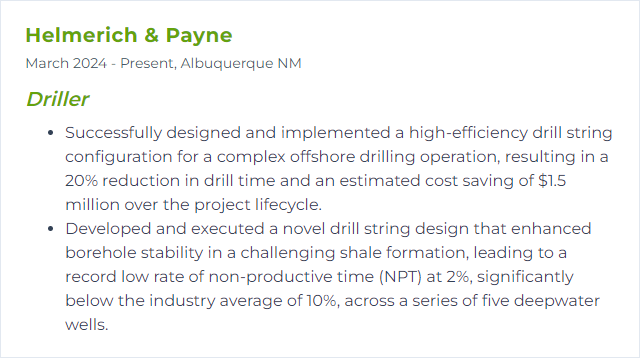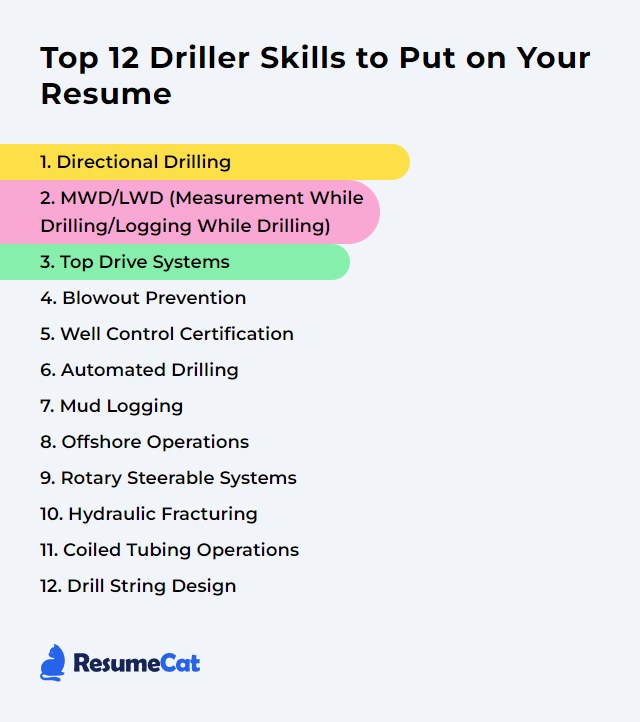Top 12 Driller Skills to Put on Your Resume
A sharp resume that actually shows what you can do—hands-on skills, proven judgment—can swing doors open fast in drilling. The list below spotlights a dozen core capabilities employers look for again and again. Nail these, show evidence, and you’ll read like someone who gets real work done.
Driller Skills
- Directional Drilling
- MWD/LWD (Measurement While Drilling/Logging While Drilling)
- Top Drive Systems
- Blowout Prevention
- Well Control Certification
- Automated Drilling
- Mud Logging
- Offshore Operations
- Rotary Steerable Systems
- Hydraulic Fracturing
- Coiled Tubing Operations
- Drill String Design
1. Directional Drilling
Directional drilling steers the wellbore along a planned 3D path—kicking off, building angle, holding, then landing—so you hit the target rock precisely while managing collision risk and surface footprint.
Why It's Important
It lets a rig reach multiple targets from one pad, thread complex subsurface corridors, and place laterals where the reservoir actually flows. More barrels, fewer pads, tighter control. That simple.
How to Improve Directional Drilling Skills
Sharper planning and execution change outcomes.
Training and skills growth: Keep current on steering methods, geosteering concepts, anti-collision practices, and torque-and-drag management.
Front-end planning: Build robust plans with anti-collision scans, torque/drag and hydraulics modeling, and contingency sidetrack options.
Real-time decisions: Use live downhole data to tweak weight, RPM, mud, and trajectory when the formation disagrees with the plan.
Tooling matters: Pair RSS and MWD with the right bit and BHA stability. Poor compatibility burns time.
Discipline on maintenance: Pre-job QA/QC for tools and sensors; post-run tear-downs to catch degradation early.
Post-well reviews: Close the loop—compare plan vs. actual, update parameter roadmaps, feed lessons into the next well.
How to Display Directional Drilling Skills on Your Resume
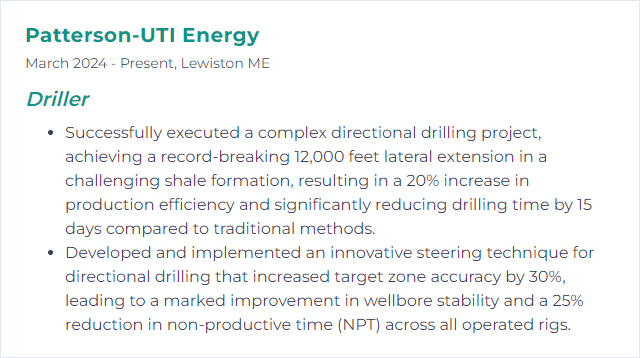
2. MWD/LWD (Measurement While Drilling/Logging While Drilling)
MWD tracks the mechanics and trajectory—inclination, azimuth, shock, temperature—while LWD reads the rocks: resistivity, density, neutron, sonic, and more. Together they turn blind drilling into informed steering.
Why It's Important
Accurate, real-time data shrinks uncertainty, keeps the wellbore in sweet spots, and flags trouble before it bites. Better placement, fewer surprises.
How to Improve MWD/LWD (Measurement While Drilling/Logging While Drilling) Skills
Calibration and QA: Routine calibrations, sensor checks, and mud property verification to keep measurements honest.
Team fluency: Train drillers and directional hands to interpret curves quickly—what to change, when to hold.
Right sensors for the rock: Select resistivity, density-neutron, or sonic suites that actually answer the reservoir question at hand.
Real-time workflows: Stream data to surface, set thresholds for alarms, and make parameter changes without delay.
Cross-discipline sync: Tight loop between geologists, drilling, and completions so data turns into decisions fast.
Vibration control: Manage shock/stick-slip to protect tools and preserve data quality.
How to Display MWD/LWD (Measurement While Drilling/Logging While Drilling) Skills on Your Resume
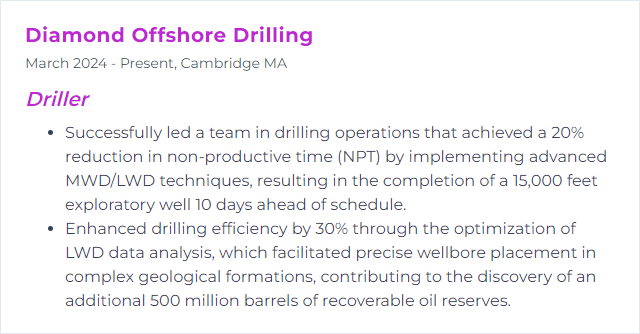
3. Top Drive Systems
Top drives rotate the string from above, feed stands without breaking rhythm, and put torque where you need it. Less manual handling. More control.
Why It's Important
Faster connections, safer floors, smooth weight transfer, and better hole quality. The rig runs cleaner, and downtime slumps.
How to Improve Top Drive Systems Skills
Stick to the maintenance clock: Gearbox, bearings, guide rails, torque track—inspect and service before they complain.
Upgrade smart: Integrate auto-drifter features, soft-torque, harmonics control, and modern software patches.
Operator training: Hands-on sessions focused on torque management, alarms, and failure signs.
Parameter discipline: Tune RPM/torque/weight windows for formation and BHA; avoid abuse that shortens tool life.
System integration: Clean handshakes with rig control systems and safety interlocks reduce human error.
How to Display Top Drive Systems Skills on Your Resume
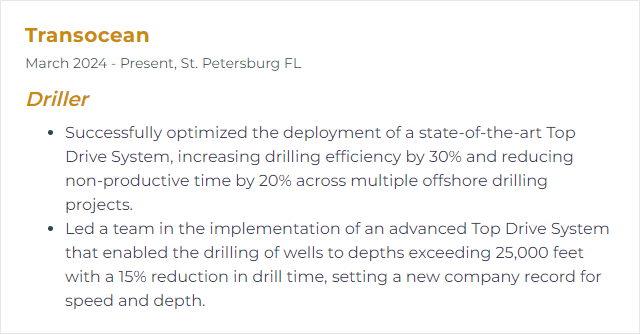
4. Blowout Prevention
BOP systems and barrier practices that keep the well under control. When pressures shift, you stay ahead of them.
Why It's Important
Because one uncontrolled influx can escalate from kick to catastrophe. Equipment, environment, people—everything’s on the line.
How to Improve Blowout Prevention Skills
Well control training: IADC or IWCF programs, frequent drills, and scenario refreshers. Repetition makes responses automatic.
Inspection and testing: Regular BOP function tests, pressure tests, and elastomer checks to standard.
Operational discipline: Clear shut-in procedures, proper trip sheets, and vigilant pit/flow monitoring.
Early detection: Trend pump strokes, flowback, gas, and standpipe pressure. Small anomalies speak loudly.
Communication: Brief every step—who calls, who shuts in, who tracks volumes. No ambiguity when seconds matter.
How to Display Blowout Prevention Skills on Your Resume
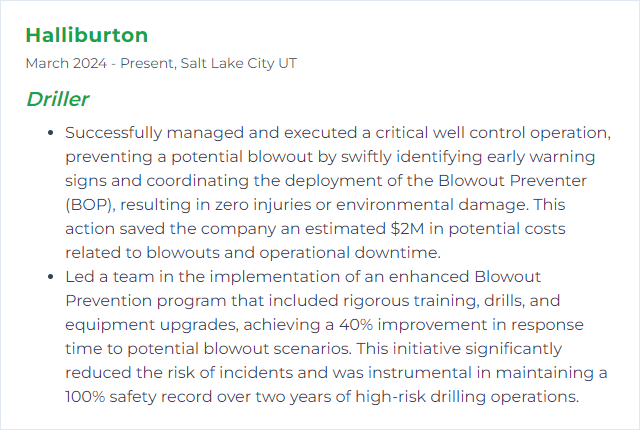
5. Well Control Certification
Formal proof you can recognize a kick, shut it in, circulate it out, and keep the well safe using the right methods and math.
Why It's Important
Employers trust certified drillers to guard the well and the crew. It reduces risk on day one.
How to Improve Well Control Certification Skills
Maintain currency: Keep IADC WellSharp or IWCF credentials active; don’t let knowledge go stale.
Use simulators: Practice choke control, complex influx scenarios, and equipment failures in high-fidelity sims.
Hands-on exposure: Apply methods on the rig—trip monitoring, shut-in drills, kill sheets under supervision.
Mentorship: Pair with seasoned supervisors who’ve managed real events.
HSE alignment: Tie well control procedures to barrier management and permit-to-work systems.
How to Display Well Control Certification Skills on Your Resume
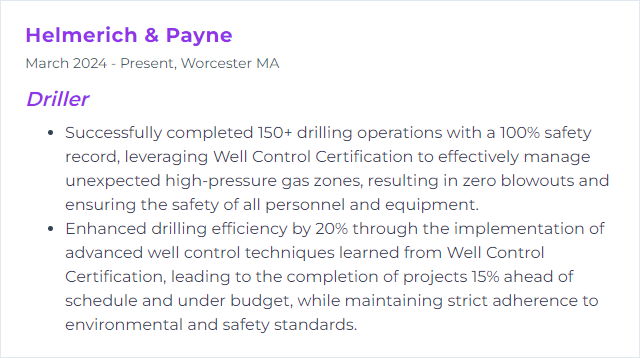
6. Automated Drilling
Control systems that sense, predict, and adjust in real time—holding weight tight, smoothing torque, and keeping the string out of trouble.
Why It's Important
Fewer manual swings, steadier parameters, less non-productive time. Safety climbs while performance stops yo-yoing.
How to Improve Automated Drilling Skills
Real-time monitoring: Stream downhole vibration, ECD, and motor stats; act on deviations quickly.
Advanced control: Use model-based or machine-learning controllers for auto driller, stick-slip mitigation, and predictive maintenance.
Navigation accuracy: Rely on MWD, gyro, and RSS feedback—GPS is for surface position, not downhole steering.
Training and safety: Teach crews how the automation thinks, when to override, and how to verify setpoints.
Upkeep and updates: Patch software, back up configurations, test alarms, and audit cybersecurity basics.
How to Display Automated Drilling Skills on Your Resume
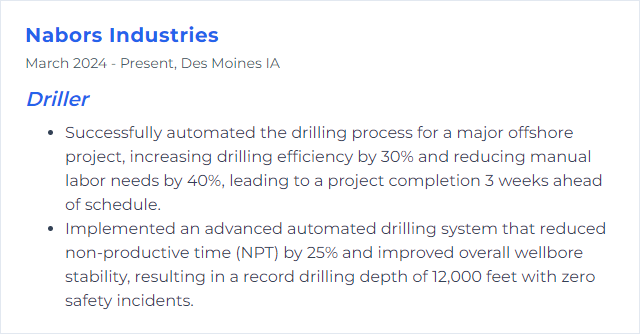
7. Mud Logging
Watching the returns. Reading cuttings, gas, and drilling parameters to understand the formation and spot trouble as it forms.
Why It's Important
It’s the earliest warning system many wells have. Gas spikes, lithology shifts, overpressure whispers—mud logging catches them first.
How to Improve Mud Logging Skills
Real-time diagnostics: High-frequency gas detection, calibrated chromatographs, and reliable lag-time management.
Integrated view: Blend mud logs with MWD/LWD and drilling mechanics; single-pane dashboards beat siloed screens.
Training: Teach consistent sample handling, staining, microscope work, and data QA.
Automation where it helps: Automated cuttings analysis and alarmed thresholds reduce misses.
Tight collaboration: Keep an open line between mud loggers, DDs, and geologists; agree on triggers before spud.
How to Display Mud Logging Skills on Your Resume

8. Offshore Operations
Drilling and intervention from platforms, jackups, floaters—far from shore, where logistics, weather, and regulation weave into every plan.
Why It's Important
Massive reserves live offshore. The work is unforgiving yet vital, and the standards are high for good reasons.
How to Improve Offshore Operations Skills
Safety as habit: Permit-to-work discipline, toolbox talks, JSAs, and barrier management embedded in the routine.
Efficiency tweaks: Batch operations, offline casing prep, and optimized tripping practices reduce crane time and waiting on weather.
Environmental care: Spill prevention, waste segregation, and well thought-out discharge limits—plan it before it’s needed.
Competency systems: Regular assessments, drills, and cross-training keep crews ready when conditions turn.
Maintenance and reliability: Condition-based monitoring, redundancy planning, and spares strategies that fit the rig’s remoteness.
How to Display Offshore Operations Skills on Your Resume
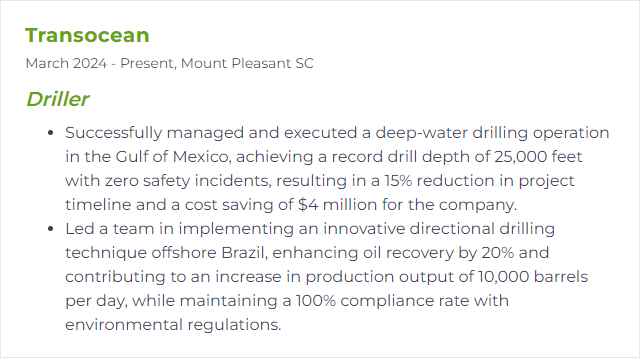
9. Rotary Steerable Systems
Continuous rotation with directional control from the surface. The bit keeps spinning, the well keeps curving, and the path stays clean.
Why It's Important
RSS delivers tighter wellbore quality, faster ROP in many formations, and stronger geosteering. Less slide time, fewer surprises.
How to Improve Rotary Steerable Systems Skills
Competency first: Train on tool modes, dogleg capabilities, and failure signatures.
Use the data: Monitor downhole vibrations, toolface stability, and steering response; tune parameters in the moment.
QA/QC and maintenance: Pre-job checks, clean mud systems, and debris control to protect sensitive internals.
BHA compatibility: Choose bits and stabilizers that play nice with the RSS architecture and target doglegs.
Feedback loops: After each run, review performance with the tool provider and update the next BHA accordingly.
How to Display Rotary Steerable Systems Skills on Your Resume
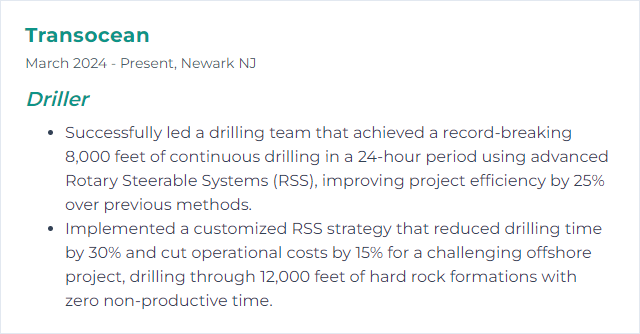
10. Hydraulic Fracturing
Pumping high-pressure fluid to crack tight rock and connect hydrocarbons to the wellbore. The magic is in the design, the chemistry, and the control.
Why It's Important
It unlocks reservoirs that won’t flow on their own. When done right, production leaps—and so does field value.
How to Improve Hydraulic Fracturing Skills
Design with intent: Model stages, run DFITs, match fluid systems and proppant to the rock, then verify with pressure diagnostics.
Cleaner chemistries: Favor lower-tox additives and friction reducers where feasible without sacrificing performance.
Watch it live: Pressure, rate, treating pressure trends, microseismic or tilt where available—adjust on the fly.
Well integrity first: Cement evaluation, pressure tests, and frac stack readiness before the first barrel moves.
Water strategy: Recycle, treat, and cut trucking where possible; plan storage and disposal up front.
Automation and safety: Automated rate control, sand handling safeguards, and emissions reduction on location.
How to Display Hydraulic Fracturing Skills on Your Resume
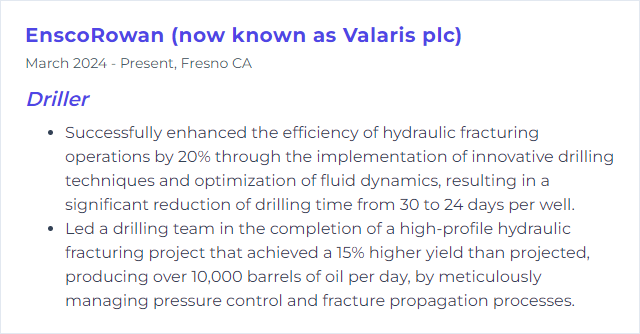
11. Coiled Tubing Operations
A continuous steel or composite tube on a reel, pushed into live wells for interventions, cleanouts, fishing, milling, and more—often without pulling the completion.
Why It's Important
It slashes downtime and cost for many interventions, supports underbalanced work, and reaches places jointed pipe can’t easily go.
How to Improve Coiled Tubing Operations Skills
Plan and model: Torque/drag, lockup risk, CT fatigue, and fluid hydraulics—simulate before execution.
Real-time tracking: Monitor differential pressure, weight on bit, and fatigue life; adjust to avoid lockup or buckling.
Relentless maintenance: Pressure control equipment, injectors, and reels need disciplined inspection and pressure testing.
Competency and drills: Train on red-zone management, pressure control, and emergency shutdown procedures.
Extend the reach: Use tractors or pulsers in long horizontals; choose BHA tools that minimize friction.
HSE focus: Barrier plans for live-well ops, clear SIMOPS rules, and crisp communication with the rig crew.
How to Display Coiled Tubing Operations Skills on Your Resume
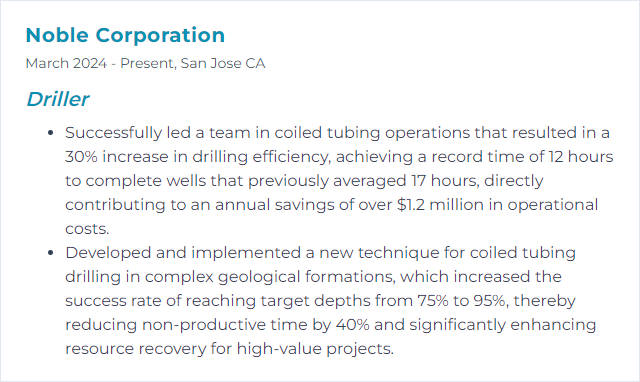
12. Drill String Design
Building the assembly—pipe, HWDP, collars, and BHA—so it survives the loads, cleans the hole, and drives the bit the way you intend.
Why It's Important
Good design prevents twist-offs and washouts, controls vibrations, and keeps hydraulics working for you, not against you.
How to Improve Drill String Design Skills
Materials and specs: Select grades per API specs that balance strength, toughness, and sour service needs.
Pipe and connections: Match OD/weight to hole sections and expected loads; choose tool joints and connections with proper torque capacity.
BHA architecture: Stabilization, bit type, motors/RSS, jars—tuned to formation and target dogleg.
Stress and dynamics: Run torque/drag and buckling checks; mitigate stick-slip and whirl with stabilizer placement and parameter windows.
Hydraulics: Model to ensure cuttings transport and bit cooling while keeping ECD in the safe zone.
Inspection program: DS-1/API inspection, NDT on critical components, and strict makeup torque control.
Contingency thinking: Plan for fishing shoulders, jars, and weak-point placement before you need them.
How to Display Drill String Design Skills on Your Resume
